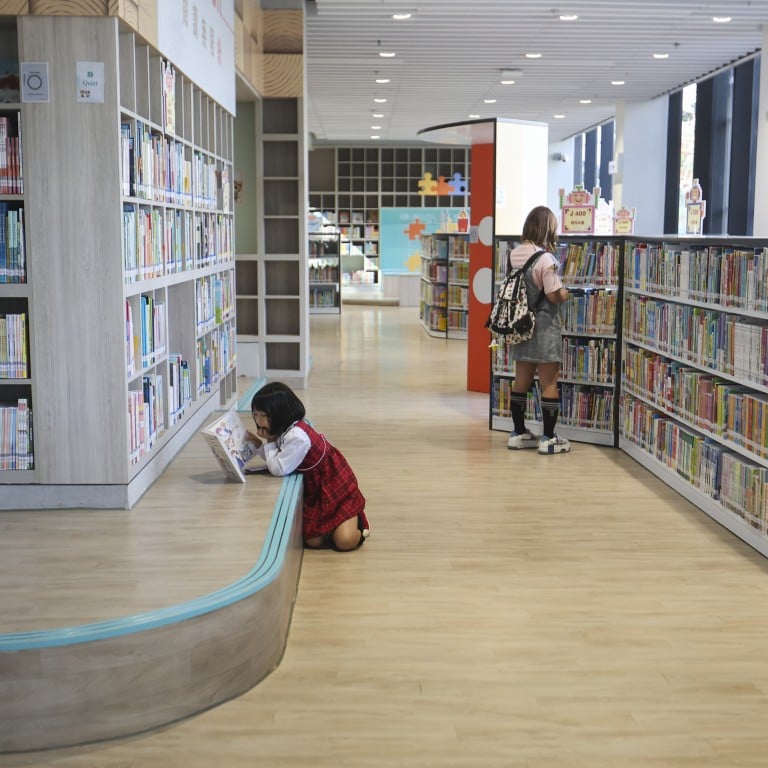
Can Hong Kong libraries win back readers? Public facilities try every trick in the book to lose ‘boring’ label amid rise of e-texts, pandemic habits
- Libraries are struggling to woo visitors despite pulling out the stops with new offerings, including more open areas and digital services
- Residents made 18 million visits to public libraries in first 10 months of year, well below 34.7 million recorded for whole of 2019
Hongkonger Garfield Leung Chun-kwan stepped out into a breezy November afternoon armed with a set of books he just borrowed from the new Sham Shui Po Public Library.
The 40-year-old training manager said he made about two trips a month to the library, drawn by its design which created a “relaxing environment”.
The two-storey library opened in March and has a spacious, open-ended layout flush with natural light from its large glass windows. Alongside books, it also has a multimedia library, computer centre and self-service kiosks.
‘Challenged books’ swept off Hong Kong library shelves, but what about shops?
But visitors who spoke to the Post said Hongkongers did not seem as drawn to the library as they expected, and the Covid-19 pandemic might be a factor.
“During the pandemic, we got used to staying at home and reading e-books,” Leung said. “It changed our habits … and maybe it’s made people less likely to go to the library.”
Despite pulling out the stops to expand offerings and modernise services, the city’s public libraries are struggling to bring back residents after years of pandemic restrictions.
Hongkongers made 18 million visits to public libraries in the first 10 months of the year, according to the Leisure and Cultural Services Department.

While that was over 50 per cent more than the nearly 12 million visits in the whole of last year, it fell well below the 34.7 million visits in 2019, before Covid-19 struck.
Wilson Chu Chun-wang, president of the Hong Kong Library Association, said the numbers reflected a “universal trend” affecting libraries around the world.
“Of course, as librarians, we are trying to reverse that trend,” said Chu, who is the librarian at the Hong Kong Design Institute.
Hong Kong’s public libraries were confronting a slide in visitors even before the pandemic. Between 2012 and 2019, physical visits declined by 14 per cent, according to the Legislative Council’s Research Office.
The trend was seen elsewhere too. In the United States, for example, library visits fell by more than a fifth in the 10 years leading up to the pandemic, according to research data and analytics group WordsRated.
Hong Kong authorities launch channels for library users to report problematic books
Chu said libraries often had a reputation for being “very boring places”, but there had been a shift in recent years to make them more interesting, by creating a more open and inviting environment to draw readers back.
The Design Institute library, which is part of an academic institution and not a public library, set aside space for students to prototype new ideas and collaborate on projects. It included 3D printers, laser cutters and other hi-tech amenities.
It was also experimenting with relaxing its rules, including some that had long been sacrosanct, such as those related to noise levels and using phones.
Chu said the efforts were paying off.

“Post-pandemic, we’ve seen more students coming back this academic year,” he said.
In a statement, the Leisure and Cultural Services Department said it recognised that the rise in e-reading and internet activities had caused the visiting habits of the public to change, and it was responding in various ways.
These included “continuously enhancing the environment and facilities of the libraries and providing a wider variety of services and facilities for the public”.
Some efforts have borne fruit. While the stock of 492,000 e-books is only 3.7 per cent of the public libraries’ physical collection, the pandemic has led to a surge in demand.
Borrowing rates have more than tripled from 960,000 in 2019 to 3.62 million in 2022, although that number has since dropped to 2.2 million so far this year.
At some public libraries, the Post observed many patrons who did not browse the books at all and headed for the other services on offer.
The naked and the read: video of woman in Hong Kong library prompts police report
At the Central Library in Causeway Bay, the largest public library, the computer areas had young and older visitors, watching online videos or other media. Study sections were filled with students doing their homework or preparing for exams.
A woman who was there with her eight-year-old daughter said they had come from their home in Kwun Tong, across Victoria Harbour, because she did not want her child to spend too much time on mobile devices.
“There’s a play area so she can read some books and play with other children,” said the 47-year-old, who declined to give her full name.
Freelance social worker Angela Yuen Ching-li, 23, said she stopped by the library once or twice a week for research as she was pursuing her goal of becoming a content creator.
She said she only picked up reading as a hobby when she was in the US for her studies, as there was a comparatively relaxed work-life balance there.
Hong Kong library books must pass review before going back on shelves: minister
Doubting that Hongkongers would take to reading, she said: “They already have so much stuff to do, they don’t have time for extra reading.”
At the Sham Shui Po Public Library, Form Six student Ivan Wong Ho-fung was busy studying for his Chinese exams. He suggested that libraries try hosting weekend workshops or experiment with reading competitions to draw visitors.
“Nowadays young people like to watch YouTube at home,” he said. “They don’t like going out as much.”

Speaking in a personal capacity, Dr Rizwan Ullah, an educator and community leader who sits on the Public Libraries Advisory Committee, said fostering a reading culture in the city would help raise the number of visitors.
He thought it was too early to say whether the dampened post-pandemic visitor numbers were a concern.
“We need one more year to see whether it's a structural issue or if it just needs time to go back up to previous levels,” he said. “But I am confident that what the public libraries are doing now will bring some good changes.”

